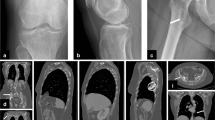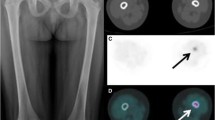Abstract
Background
Bone involvement in Langerhans' cell histiocytosis (LCH) is common. Both bone scintigraphy and plain films are used to identify osseous lesions, but lack specificity for disease activity and response to therapy. FDG-PET is a sensitive technique for identifying bone lesions when histiocytes are present.
Objective
To describe the potential of coincidence FDG-PET (cFDG-PET) for identification of active bone lesions in LCH and to determine whether it can provide more specific information regarding lesional response to therapy than bone scintigraphy or radiography.
Materials and methods
The clinical data and imaging findings of three patients with osseous lesions of LCH were retrospectively reviewed.
Results
cFDG-PET identified all active LCH osseous lesions in these patients, differentiated active from healed lesions, and demonstrated normalization of uptake in a treated lesion earlier than bone scintigraphy and radiography.
Conclusion
cFDG-PET appears to have greater specificity than bone scintigraphy and radiography for the identification of active osseous lesions in LCH. It also may predict response to treatment earlier than conventional techniques. Its use in the evaluation of LCH warrants further study.




Similar content being viewed by others
References
Ladish S, Jaffee ES (2002) Histiocytosis. In: Pizzo PA, Poplack DG (eds) Principles and practice of pediatric oncology, 4th edn. Lippincott, Williams & Wilkins, Philadelphia, pp 733–750
Meyer JS, De Camargo B (1998) The role of radiology in the diagnosis and follow-up of Langerhans cell histiocytosis. Hematol Oncol Clin North Am 12:307–326
Broadbent V, Gadner H, Komp DM, et al (1989) Histiocytosis syndromes in children: approach to the clinical and laboratory evaluation of children with Langerhans cell histiocytosis. Med Pediatr Oncol 17:492–495
Aoki J, Watanabe H, Shinozaki T, et al (2001) FDG PET of primary benign and malignant bone tumors: standardized uptake value in 52 lesions. Radiology 219:774–777
Aoki J, Inoue T, Tomiyoshi K, et al (2001) Nuclear imaging of bone tumors: FDG-PET. Semin Musculoskeletal Radiol 5:183–187
Egeler RM, D'Angio GJ (1995) Langerhans cell histiocytosis. J Pediatr 127:1
Howarth DM, Mullan BP, Wiseman GA, et al (1996) Bone scintigraphy evaluated in diagnosing and staging langerhans' cell histiocytosis and related disorders. J Nucl Med 37:1456–1460
Crone-Munzebrock W, Brassow F (1983) A comparison of radiographic and bone scan findings in histiocytosis X. Skeletal Radiol 9:170–173
Van Nieuwenhuyse JP, Clapuyt P, Malghem J, et al (1996) Radiographic skeletal survey and radionuclide bone scan in langerhans cell histiocytosis of bone. Pediatr Radiol 26:734–738
Sartoris DJ, Parker BR (1984) Histiocytosis X: rate and pattern of resolution of osseous lesions. Radiology 152: 679–684
Wahl RL (2002) Principles and practice of positron emission tomography. Lippincott, Williams & Wilkins, Philadelphia
Dehdashti F, Siegel BA, Griffeth LK, et al (1996) Benign versus malignant intraosseous lesions: discrimination by means of PET with 2-[F-18] fluoro-2-deoxy-D-glucose. Radiology J200:243–247
Kole AC, Nieweg OE, Hoekstra HJ, et al (1998) Fluorine-18-fluorodeoxyglucose assessment of glucose metabolism in bone tumors. J Nucl Med 39:810–815
Positron diagnostics (1997) Fludeoxyglucose F18 injection [18F] FDG diagnostic—for intravenous administration
Bracco diagnostics (1997) MDP Bracco, kit for the preparation of technetium Tc 99m medronate
Kirks DR (1991) Practical pediatric imaging, 2nd edn. Little, Brown, Boston, p 1064
Author information
Authors and Affiliations
Corresponding author
Additional information
Presented at the 2002 meeting of the Society for Pediatric Radiology, Philadelphia, Pennsylvania
Rights and permissions
About this article
Cite this article
Binkovitz, L.A., Olshefski, R.S. & Adler, B.H. Coincidence FDG-PET in the evaluation of Langerhans' cell histiocytosis: preliminary findings. Pediatr Radiol 33, 598–602 (2003). https://doi.org/10.1007/s00247-003-0943-4
Received:
Accepted:
Published:
Issue Date:
DOI: https://doi.org/10.1007/s00247-003-0943-4




